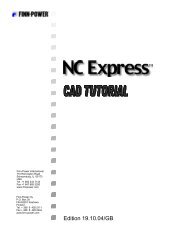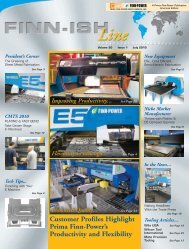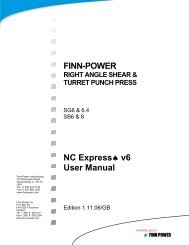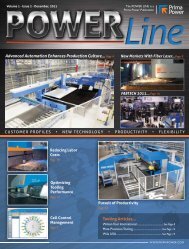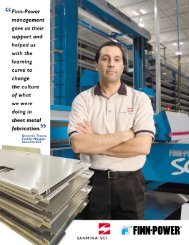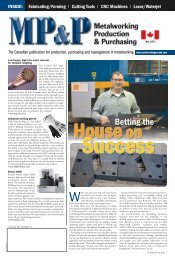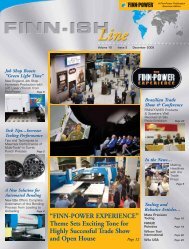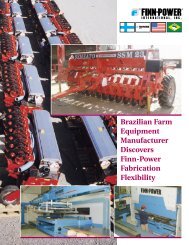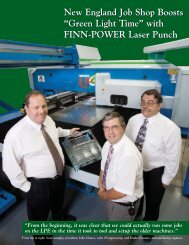Stand-Alone Punch machine user manual - Finn-Power International ...
Stand-Alone Punch machine user manual - Finn-Power International ...
Stand-Alone Punch machine user manual - Finn-Power International ...
Create successful ePaper yourself
Turn your PDF publications into a flip-book with our unique Google optimized e-Paper software.
a. Open the Nest dialog and select the Plate list.<br />
b. Choose ‘Use smallest’ from Plate utilization and Click OK.<br />
The smaller plate was selected because the largest part (AutotoolSA.cp) was<br />
large enough to fit on the smallest plate listed- 80”x40” (2000mmx1000mm).<br />
To utilize Use smallest when nesting with multiple plates listed will allow the<br />
nest engine to find the suitable plate size for scheduled parts, but sometimes will<br />
not find the ideal plate size needed. Use smallest is typically used when nesting<br />
large parts mixed with small parts.<br />
5.7 Common Line Nesting (<strong>Punch</strong> Tooling only)<br />
The meaning of common line nesting is simple; a part that shares the same<br />
symmetrical shape will overlap external tooling within the plate when nested.<br />
Basically, when the part is nested similar sides will nest tooling directly on top of<br />
each other following a common line (using spacing entered- Part Separation).<br />
Common line allows for tighter part nesting and less punch hits, thus, saving time at<br />
the <strong>machine</strong>. Not all parts are capable of being common line nested automatically<br />
within NC Express.<br />
5.7.1 Types of Parts<br />
AutotoolSA.cp part from Autotool exercise is an example of a part that will not<br />
automatically common line. This is because the notch is not able to match up with<br />
any of the rotations. This type of part can be common lined, but requires editing<br />
with Grid Parts within the Drawing menu. Parts that are rectangular or square with<br />
symmetrical notches in the corners or edges are capable of common lining.<br />
5.7.2 Activating Common Line<br />
There are two options to enable to allow Common Line- Part Properties and Nest<br />
dialog. Within the part properties dialog is the option to enable common line for a<br />
part. Enabling this option activates common line capability for a part within the<br />
nest. Allowing this option to be activated for all parts does not mean that all parts<br />
capable of being common lined. It is important to remember that the nest engine<br />
will only common line the same part only that shares symmetrical geometric<br />
entities.<br />
The other option to activate common line is within the nest dialog. When common<br />
line is activated in the nest dialog only the same parts will be nested common lined<br />
with each other. Not all parts will be nested sharing tooled edges. When a part has<br />
common line active, the nest engine will recognize this and only nest the<br />
symmetrical parts. If a part that is not symmetrical and has common line active<br />
within the part properties, the part will not be common lined. Other parts scheduled<br />
within the nest’s part list that do not have common line enabled will not be common<br />
lined either.<br />
5-92




